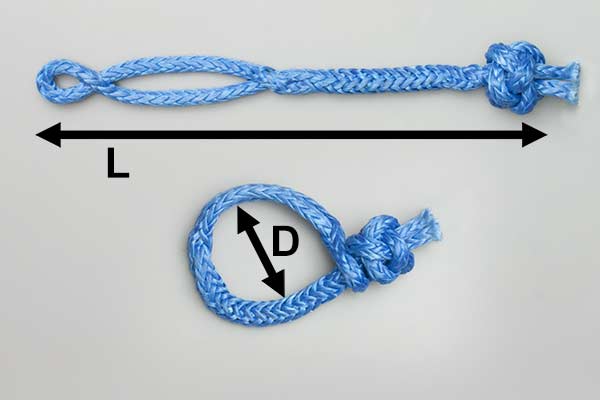Neat method of creating a soft shackle in hollow-braid rope.
Soft Shackle
Neat method of creating a soft shackle in hollow-braid rope.
 |  |

 |  |  |  |  |
To Step use Arrow Keys (
Purpose: A Soft Shackle offers a strong lightweight alternative to a metal shackle.
Name: A Better Soft Shackle was proposed by Allen Edwards, the originator of this design and Webmaster of L-36.com.
Alternative: The commoner Soft Shackle is made with the lines running inside each other – elegant but may be harder to release. The Kohlhoff Shackle has the loop composed of two lines all the way around.
Technique: Edwards provides detailed written instructions on his page. He also emphasizes that final tightening of the Lanyard (Diamond) Knot is critical. He passes the two tails through a hole in a metal bar and exerts traction using vice-grip pliers – look near the bottom of: Better Soft Shackle page. The tightened knot should feel like a wooden ball and, if not extremely tight, Edwards warns it may slip.
Lengths Needed: The Edwards Calculator bases the lengths required on the shackle length. The calculator below is based on the finished inner diameter and allows input in either English or Metric units. Enter the inner diameter of the finished shackle and the diameter of the rope you are using. Measurements for are taken from the tip of the small loop (Red marks in Frame 4).
The Usable Inner Diameter is somewhat smaller than the Inner Diameter (D) because the process of closing the shackle takes up some of the line. (Note: the calculation is derived from Edwards method and the results are similar).
To calculate these values manually, first calculate S (Stretch):
- If D = 7/64" (or 2mm), S = 1.1875
- If D = 1/8" (or 3mm), S = 1.23
- If D = 5/32" (or 4mm), S = 1.23
- If D = 3/16" (or 5mm), S = 1.21538
- Otherwise S = 1.2
Where:
- R = Rope diameter, e.g., 0.25",
- D = Intended Diameter of Shackle, e.g., 2":
Then:
- Rope Length required =112 x R + (1 + S) x (D + 1.5 x R) x 3.1416
- Mark 1 = 16 x R
- Mark 2 = 16 x R + S x ((D + 1.5 x R) x 3.14159 - 13.11 x R)
- Maximum Load Diameter = D - 1.9099 x R
- Shackle Length (tip to beneath knot) = 3.1416 x D + 10.272 x R
Tail Lengths: If the knot has been adequately tightened, trim the tails to about 1/4" long. If not really tight, then leave at least an inch.
Use: The completed shackle provides an excellent way of attaching two jib sheets to the jib – see photo on left courtesy of Allen Edwards. Here Edwards uses a Velcro Strap to keep the Lanyard Knot centered in the ring and out of the way of the rigging.
Advantages: The soft shackle weighs little and is less likely to cause injury if it strikes a crew member. The array of soft shackle and jib sheets pulls across in front of a mast with little tendency to catch - reducing the need to place a crew member up on the foredeck. This version is harder to release than the Edwards Soft Shackle.
Strength: Soft shackles have been extensively tested. The ideal strength might approach four times the line strength as there are two lines on each side of the shackle – four in all. In practice, the line just under the knot and the kinking in the loop are the weak points and Evans Starzinger has shown that breakage typically occurs around 175% of Line Strength. This means when attached to a jib sheet using similar rope, the sheet will part first – not the soft shackle.










